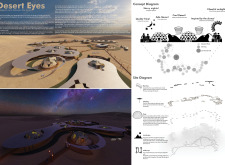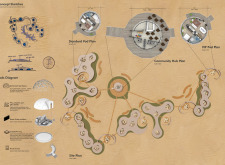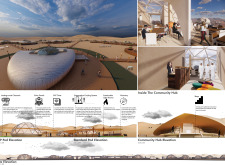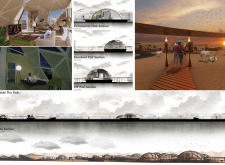5 key facts about this project
Desert Eyes is located in the Arabian Oryx protected area in the UAE, providing a retreat that emphasizes balance with the surrounding desert landscape. The design concept draws inspiration from the forms and textures of desert dunes, resulting in a structure that connects well with its natural environment. The project features bubble-like pods that offer both visual appeal and functional spaces for individuals and groups.
Design Concept
The goal is to create an oasis that relates directly to the desert surroundings. The organic shape of the pods reflects the gentle curves of the dunes, providing views of the expansive sky and particularly the star-filled Milky Way. This design choice creates an inviting atmosphere, allowing visitors to feel the vastness while enjoying moments of personal space.
Materiality
Materials include PVC, which is used for the construction of the tent-like structures. This choice highlights the need for a lightweight yet durable solution. The tents protect visitors from the sun and contribute to the overall aesthetic. Solar panels are also a part of the project, supplying energy to the pods and allowing for efficient use of resources while appreciating the environment.
Functional Integration
Pathways connect the pods and facilitate movement. These clear routes encourage exploration and interaction with both the environment and other visitors. The layout serves diverse uses, from communal gatherings to quiet retreats. Benches echo the shapes of the dunes, providing opportunities for rest and contemplation, reinforcing the relationship between structure and landscape.
Sustainability Features
An innovative waste management system is in place, directing waste into green areas where it can naturally decompose and serve as fertilizer for irrigation. This integration reflects a commitment to sustainability and ecological health, ensuring that the design supports the local environment.
The transparent roofs of the pods enhance the experience by offering unobstructed views of the night sky. Visitors are encouraged to gaze upward and fully appreciate the desert’s beauty after sunset, maintaining a connection with the incredible natural world around them.






















































